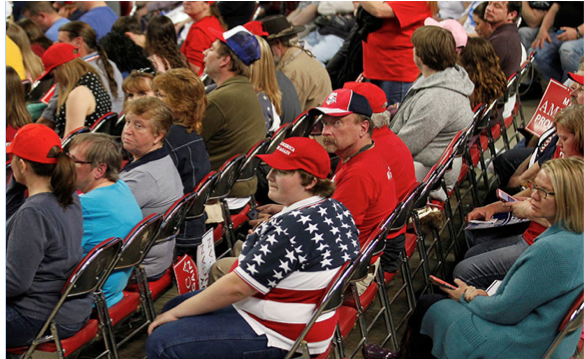CommentsPERSPECTIVE--A recent poll showed Donald Trump’s approval rating at 37 percent. This compares unfavorably with every president since pollsters started tracking these attitudes. Those on the left are gleefully pointing to these numbers as proof that many who voted for Trump are experiencing buyer’s remorse. Those on the right are dismissing the poll results as fake news.
That 37 percent is meaningful for another reason. It represents, more or less, the hardcore Trump supporters. Probably about a third of Americans will believe, buy and blindly endorse anything and everything they are told by Fox News, alt-right websites, and anyone working for the White House propaganda machine.
Last year, at the time of the Republican national convention, I read a lengthy Q & A with operatives from the campaigns of three of Trump’s primary season opponents -- Ted Cruz, Marco Rubio, and Jeb Bush. The major takeaway was that Trump started his campaign with a solid base of about one-quarter of the Republican electorate.
One of those interviewed talked about daily polling done by his campaign organization which showed that this base never wavered. It didn’t matter what Trump said or did, these voters were with him. The campaign managers all said they expected Trump would finally step over the line and his support would fade. That never happened.
In January 2016, Trump said, “I could stand in the middle of Fifth Avenue and shoot somebody and wouldn’t lose any voters, O.K.? It’s, like, incredible.” He was talking about the loyalty of his supporters. He wasn’t kidding. Thanks to that loyalty, Trump always had a head start on his rivals for the Republican nomination. It was an advantage he understood and exploited to maximum advantage.
It’s an advantage he’s still exploiting. That’s why he’s out on the campaign trail again, giving speeches in places such as Florida and Kentucky, where he can turn out a friendly crowd. Don’t expect to see him in Los Angeles anytime soon.
Who are these people, the 37 percent? Typically, they are more rural than urban. They are less educated. They tend to be less well off in economic terms. A large number of them are socially conservative and, considering Trump’s life story, surprisingly religious. More than anything else, they are white.
Much is made of Trump’s popularity in small towns. Most everywhere in America, small town means white. Congressman Steve King of Iowa recently praised Dutch anti-immigrant politician Geert Wilders, tweeting, “Wilders understands that culture and demographics are our destiny. We can’t restore our civilization with somebody else’s babies.”
A lot of commentators condemned King’s statement. King didn’t think it was a big deal and said many of his Congressional colleagues congratulated him on his words. His district in Iowa is 97 percent white. Trump took about 61 percent of the vote there.
For all the talk about economics and making America great again, it’s hard not to conclude that a large chunk of Trump’s believers are motivated by racism. Go to places like northwestern Iowa and ask people if they are racist. Almost all will say no. Ask them if that means they would accept their child marrying a person of another color and you will be met with stony silence. Or maybe you’ll be run out of town.
Democrats talk about needing to develop a message about jobs and revitalizing the manufacturing economy as a tool to reach voters in small towns in the heart of America. What these politicos really need to understand is that it will never work. For too many outside the big cities, Democrat is a dirty word. Whether it’s one of three or one of four, there will always be a hard core of the electorate for whom skin color beats all other considerations.
(Doug Epperhart is a publisher, a long-time neighborhood council activist and former Board of Neighborhood Commissioners commissioner. He is a contributor to CityWatch and can be reached at: [email protected]) Prepped for CityWatch by Linda Abrams.
Explore
Our mission is to promote and facilitate civic engagement and neighborhood empowerment, and to hold area government and its politicians accountable.

 CityWatch Los Angeles
Politics. Perspective. Participation.
CityWatch Los Angeles
Politics. Perspective. Participation.
21
Fri, Nov













